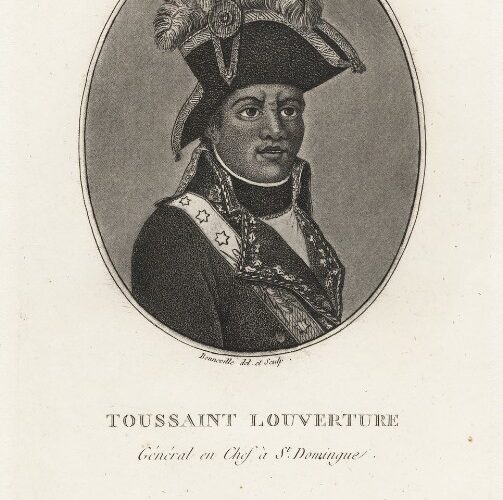Toussaint Louverture, Chief of the French Rebels in St Domingo
Theme: Revolutionary ideas, Haitian revolution (1791 - 1804), Challenging slavery: abolition and opposition, War and the international order
Toussaint Louverture (1743 – 1803) was born into slavery in St Domingue (now Haïti) on the Caribbean island of Hispaniola. In 1791 he led the first – and only – successful uprising of enslaved Africans. Although he died before the revolution spawned a nation, in 1804 Haiti became the first independent ‘black’ republic and contributed to the decline of the transatlantic slave trade. The events in St Domingue became known as the Haitian Revolution. This and other depictions of Louverture (in print and portraiture) reflected the high levels of fascination and respect expressed around the world for a radical figure who had refused to yield and who surmounted all foes in the revolutionary contests.
By the 1790s many of the islands in the Caribbean had long been occupied by European countries and populated by slaves such as Louverture, forced to work on plantations producing sugar, coffee, indigo and other commodities. St Domingue was controlled by France.
In 1791, Louverture (who had been freed some years earlier and now worked as an employee on the sugar estates of the northern plains) led an uprising of enslaved people in St Domingue, revolting against the French plantation owners and the system of slavery, which had brutally oppressed them and their ancestors for almost three centuries. This marked the beginning of the Haitian Revolution. When Spain declared war on France in 1793, Louverture and his ‘army of slaves’ joined forces with the Spanish, who promised freedom for slaves who fought with them. When these promises didn’t materialise, Louverture switched sides and began fighting with the French whose new governor supported the abolition of slavery.
Between 1794-1801, Louverture fought with extraordinary tenacity against the Spanish and British armies who tried to invade St Domingue, and against the plantation owners and pro-slavery supporters within St Domingue society. He finally gained complete control and proclaimed himself ruler for life of Saint Domingue in 1801. However, although Louverture declared himself a subject and supporter of France, Napoleon Bonaparte saw him as a threat to his plans for the French Empire and to the profits he could derive from slavery. Napoleon dispatched an expedition on a secret mission to Saint Domingue to arrest Louverture and, in all probability, restore slavery. Despite his best efforts, Louverture was betrayed by his generals and forced to surrender. He was shipped back to France, where he died in prison in 1803.
One of Louverture’s lieutenants, Jean-Jacques Dessalines, continued the bloody fight for permanent freedom and national independence. When French forces surrendered in 1804, Dessalines declared St Domingue a republic, renaming it ‘Haiti’, with Dessalines himself as Emperor.
Did you know..?
International Slavery Remembrance Day is still marked every year on 23 August, the anniversary of the uprising in St Domingue and the start of the Haitian Revolution.
Sources & acknowledgements
This object description and its related educational resources were researched and written by our team of historians and education specialists. For further information see the item’s home museum, gallery or archive, listed above.
- Enquiry Questions
-
Did you know..?
International Slavery Remembrance Day is still marked every year on 23 August, the anniversary of the uprising in St Domingue and the start of the Haitian Revolution.
-
Education overview
You can access a range of teachers resources related to this object and more on our education page.
Please also see our glossary of terms for more detailed explanations of the terms used.
-
Curatorial info
- Originating Museum: National Portrait Gallery
- Accession Number: NPG D8212
- Production Date: early 19th Century
- Creator: François Bonneville
- Material: Paper
- Technique: etching and aquatint
- Size: 298 mm x 210 mm
- Original record
-
Use this image
You can download this image for personal and educational use but please take note of the license type below.
- Rights Holder: © National Portrait Gallery, London
- License Type:
Find it here
This object is in the collection of National Portrait Gallery



